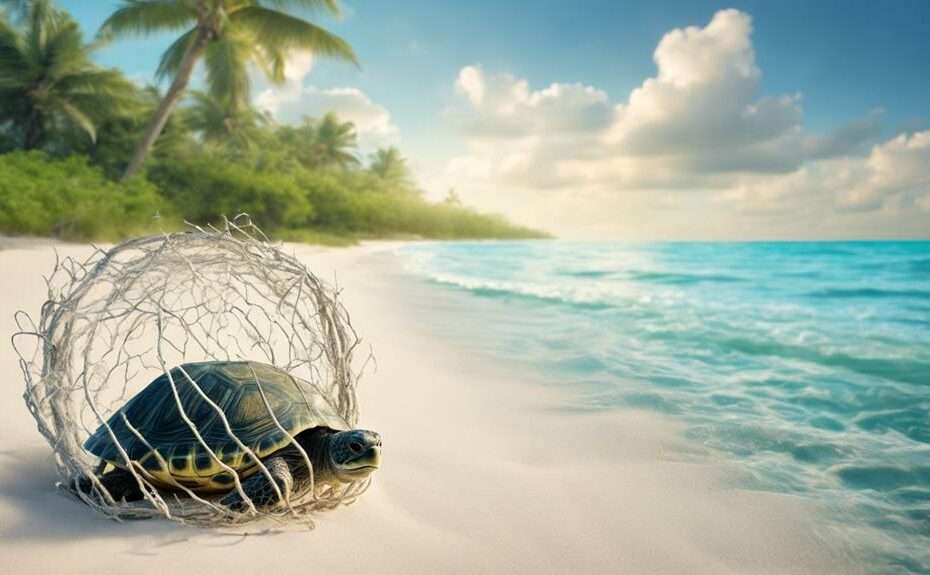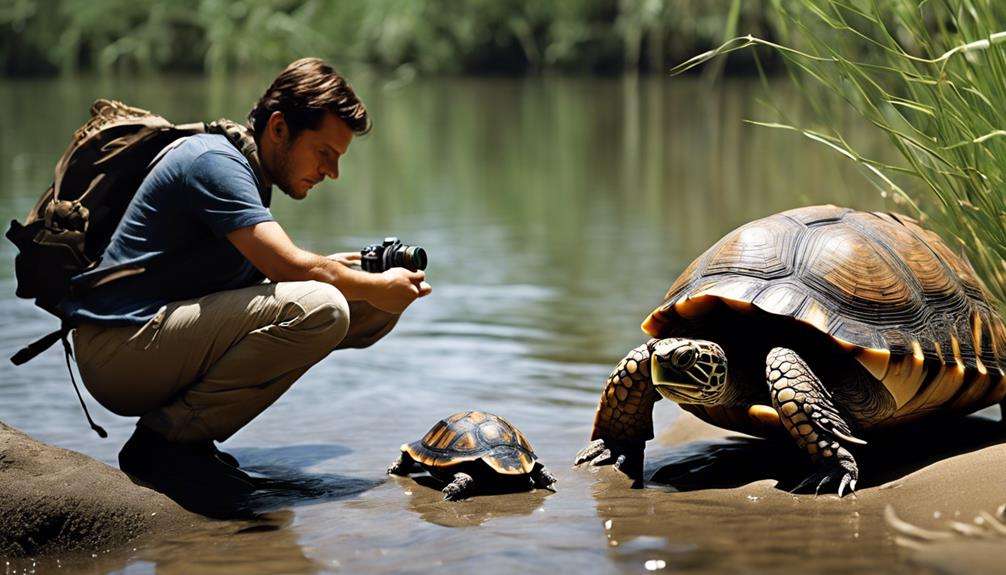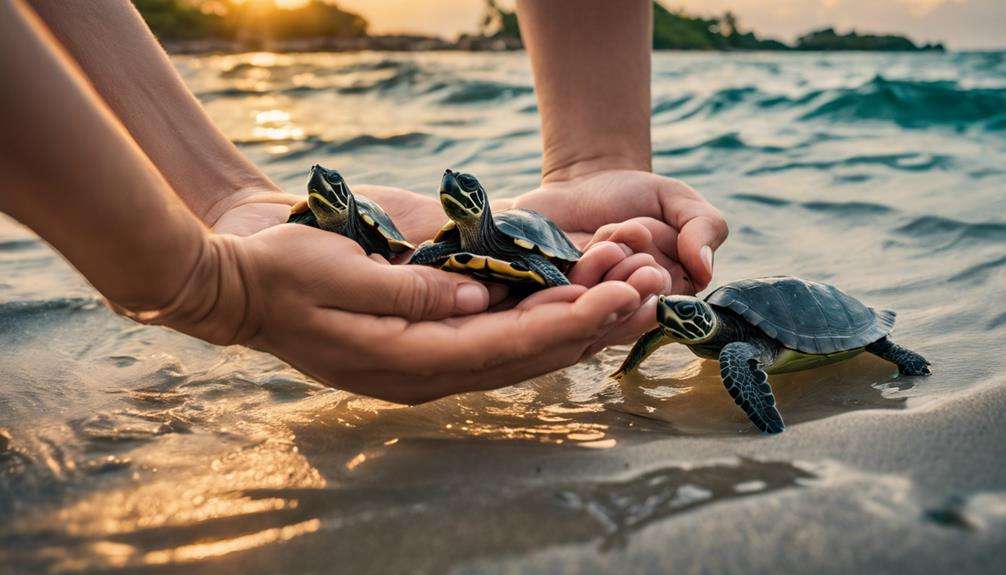Have you ever wondered what essential care tips can truly make a difference in protecting endangered turtle breeds? Understanding the specific needs and challenges these magnificent creatures face is the first step towards ensuring their survival.
By exploring key aspects such as habitat, nutrition, health, and legal considerations, you can gain valuable insights into how to best support these vulnerable species.
Stay tuned to discover practical tips and strategies that can help safeguard endangered turtle breeds for generations to come.
Key Takeaways
- Understanding threats and habitats is crucial for effective conservation.
- Targeted efforts protect rare turtle species like Kemp's ridley and leatherback.
- Proper habitat management and veterinary care are essential for their well-being.
- Collaborative approaches between experts ensure the survival of endangered turtles.
Importance of Protecting Rare Turtles
Protecting rare turtle breeds is essential for maintaining ecosystem balance and preserving genetic diversity within their populations. Sea turtle species, in particular, are important in marine environments due to their roles in controlling jellyfish populations and maintaining seagrass beds. By safeguarding these endangered species, you aren't only ensuring their survival but also contributing to the overall health of marine ecosystems.
Endangered sea turtle species, such as the Kemp's ridley turtle and the leatherback turtle, are designated as Endangered Species, highlighting the urgent need for conservation efforts. These turtles face numerous threats, including habitat destruction, pollution, climate change, and bycatch in fishing gear. Your actions to protect sea turtles can help mitigate these risks and secure their populations for future generations.
Preserving genetic diversity within sea turtle populations is important for their long-term survival. By supporting conservation initiatives and advocating for sustainable practices, you play an important role in safeguarding these magnificent creatures and maintaining the delicate balance of marine ecosystems.
Understanding Endangered Turtle Breeds
To safeguard rare turtle species like the Kemp's ridley, hawksbill, and leatherback sea turtles, understanding the threats they face is essential.
Factors such as habitat loss, poaching, and climate change pose significant risks to their survival. Recognizing these challenges enables targeted conservation efforts to protect and restore their populations effectively.
Rare Turtle Species
The rare turtle species, including Leatherback, hawksbill, and Kemp's ridley turtles, are facing significant threats to their survival. These marine turtles play vital roles in the ecosystem, making sea turtle conservation efforts essential.
The critically endangered Kemp's ridley turtle, known for nesting along the Gulf of Mexico coast, is particularly vulnerable. Hawksbill turtles are also critically endangered, primarily due to poaching for their prized shells. Leatherback turtles, the largest of all sea turtles, are at risk of entanglement in fishing gear, further endangering their populations.
Understanding the unique characteristics and habitats of these rare turtle species is paramount for effective conservation strategies. By addressing the threats they face, we can work towards safeguarding these magnificent creatures for future generations.
Threats to Survival
Rare turtle species, such as the Leatherback, hawksbill, and Kemp's ridley turtles, are confronted with a multitude of threats to their survival. Habitat destruction, driven by human activities like coastal development, poses a significant risk to nesting beaches essential for their reproduction.
Climate change exacerbates these challenges, leading to rising sea levels and increased storm intensity that can destroy nesting sites. Illegal poaching further endangers these already vulnerable populations, driven by the demand for turtle products in various markets.
These threats, combined with pollution and limited genetic diversity, put these endangered turtle breeds at a high risk of extinction. Understanding and addressing these issues are vital for the conservation and protection of these magnificent creatures.
Providing Proper Habitat for Rare Turtles
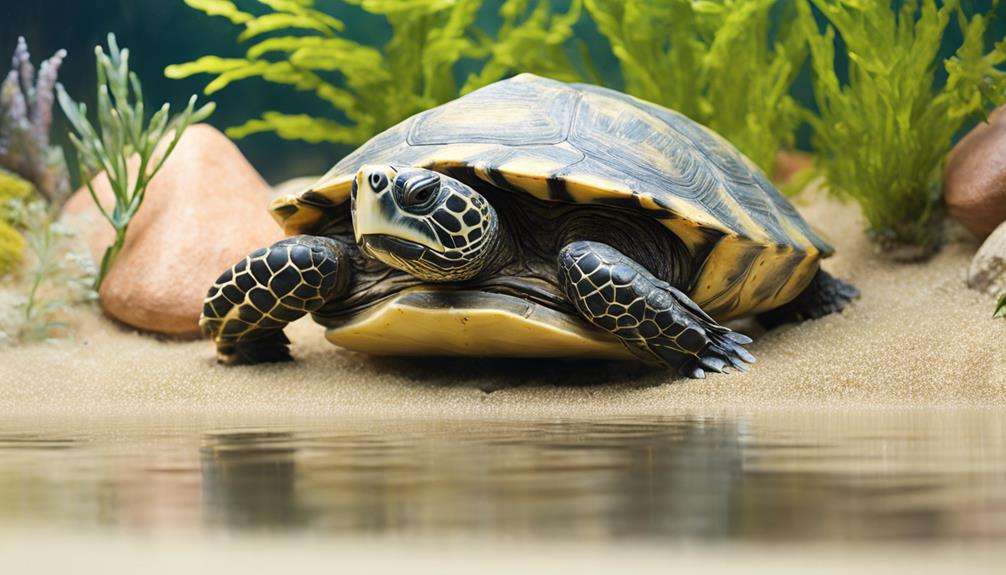
Rare turtle breeds require specific tank conditions, including ideal temperature, humidity, and lighting levels to support their well-being.
Creating a naturalistic environment with suitable nesting areas and well-drained soil is essential for these rare turtles to reproduce successfully.
Ensuring the appropriate temperature and lighting requirements are met is vital for the health and development of endangered turtle species.
Ideal Tank Conditions
To create a perfect habitat for rare turtles, ensuring proper tank conditions is essential for their well-being and longevity. For female sea turtles during nesting season, it's important to maintain water temperature between 75-80°F. Additionally, providing UVB lighting is key to support calcium absorption and shell health.
The tank size should be appropriate for the turtle's size and behavior, offering ample space for movement. Include a basking area with a heat lamp to aid in thermoregulation, allowing the turtle to regulate its body temperature effectively.
Implementing a reliable water filtration system is also necessary to keep the tank clean and free of waste, ensuring a healthy environment for the rare turtles to thrive.
Naturalistic Environment Setup
When setting up a naturalistic environment for rare turtles, it's essential to guarantee factors such as temperature, lighting, and habitat features for their well-being and adaptation.
Sea turtles, especially nesting females, require a habitat that mimics their natural environment to thrive. To create this setting, use substrates like sand, soil, or aquatic plants to replicate their nesting grounds.
Provide clean water at the right temperature for swimming and hydration, essential for the marine life that these turtles are accustomed to. Incorporate basking areas with UVB lighting to support their health and metabolism.
Enrich the habitat with rocks, logs, and plants to offer stimulation for these rare turtle breeds, ensuring they've a space that promotes their overall well-being.
Temperature and Lighting Requirements
In establishing the ideal habitat for rare turtles, ensuring precise temperature control and appropriate lighting conditions is paramount for their well-being and adaptation. Rare turtle breeds, such as sea turtles, may require specific temperature ranges, particularly when nesting, to support best health. Warmer temperatures are important for incubation and development.
Lighting is equally significant, as it helps mimic natural habitats, especially for endangered turtle species. Providing UVB lighting can aid rare turtles in regulating their metabolism and absorbing important calcium.
Maintaining proper temperature gradients within the habitat is essential for the overall health of these endangered turtle breeds. Monitoring and controlling temperature and lighting conditions are important aspects of caring for rare and endangered turtle species, ensuring their survival and well-being.
Nutrition and Diet for Endangered Turtles

Endangered turtle breeds may exhibit specific dietary requirements important for their health and well-being. Providing a balanced diet is critical to meet the nutritional needs of endangered turtles. A diet rich in leafy greens, vegetables, fruits, and occasional protein sources can support their overall health. Some endangered turtle species may benefit from calcium or vitamin supplementation to prevent deficiencies. It's essential to avoid feeding endangered turtles processed foods, high-sugar items, or foods that could harm their digestive system.
Consulting with a reptile veterinarian or specialist can aid in creating a tailored nutrition plan for endangered turtle breeds. These professionals can offer guidance on meeting the specific dietary needs of rare turtles to promote their well-being. By following a well-rounded and species-appropriate diet, you can contribute to the protection and preservation of endangered turtle breeds. Remember, proper nutrition plays a crucial role in ensuring the health and longevity of these magnificent sea creatures.
Health and Veterinary Care for Rare Turtles
For rare turtle breeds, specialized veterinary care tailored to their unique biology and habitat requirements is essential for ensuring their well-being and conservation. When it comes to the health of endangered marine turtle species, thorough assessments are critical. These assessments often involve blood tests, physical exams, and imaging techniques to monitor the turtles' overall health status. Veterinary care for these rare turtles focuses on disease prevention, parasite control, and ensuring proper nutrition to support their conservation efforts.
In cases where endangered turtle breeds require medical intervention, treatments such as antibiotics, surgeries, and rehabilitation may be necessary to improve their health and increase their chances of survival in the wild. Collaborative efforts between veterinarians, biologists, and conservationists are paramount in providing the essential care needed for these rare turtle species. By working together, they can ensure that the health and well-being of endangered marine turtles are safeguarded, contributing to the overall conservation of these precious species.
Handling and Interaction Guidelines for Endangered Turtles
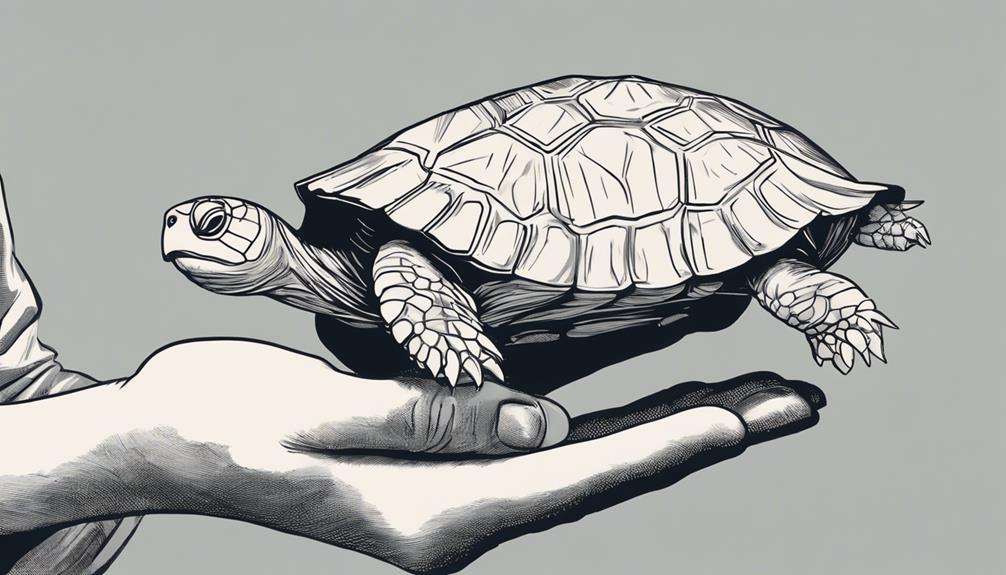
When handling endangered turtles, it's important to adhere to strict guidelines to minimize stress and potential harm to these vulnerable species. Sea turtles, a critical part of marine ecosystems, require special care and consideration to make certain their conservation. Conservation organizations provide essential guidelines for interacting with endangered turtles, emphasizing the importance of limiting direct contact to reduce human-induced stress. Minimizing physical interaction also helps prevent the transmission of diseases and parasites that could further endanger these species.
Respecting the natural behaviors and habitats of endangered turtles is paramount in handling them safely. By following established protocols, individuals can contribute to the well-being and preservation of these magnificent creatures. It's essential to prioritize the conservation of sea turtles by avoiding unnecessary handling and disturbances to their environment. Through careful adherence to recommended guidelines, we can play a significant role in protecting these endangered turtles for future generations.
Breeding and Reproduction of Rare Turtles
Studying the breeding and reproductive behaviors of rare turtle breeds is essential for their long-term conservation and survival. Rare turtle breeds often exhibit specific breeding seasons and nesting habits, such as female sea turtles returning to the same beaches to lay their eggs. Understanding these patterns is critical for conservation efforts, as some endangered turtle species have low reproductive rates, making each successful breeding event significant.
Conservation initiatives frequently prioritize protecting nesting sites and ensuring the survival of hatchlings. By monitoring and studying the breeding patterns of rare turtles, conservationists can gather valuable data to inform and improve conservation strategies. This research-driven approach plays a significant role in safeguarding the future of these endangered turtle breeds, emphasizing the importance of proactive measures to support their breeding and reproduction.
Legal Considerations for Protecting Endangered Turtle Breeds

Compliance with local and international laws is imperative in safeguarding endangered turtle breeds, especially concerning illegal trade and trafficking threats. Female sea turtles, in particular, face risks such as being caught unintentionally in fishing gear or targeted for their eggs, meat, or shells.
International Trade regulations, like the Convention on International Trade in Endangered Species of Wild Fauna and Flora (CITES), aim to control and monitor the cross-border movement of endangered turtle species. These legal frameworks provide guidelines for conservation efforts and support in safeguarding critical habitats for these vulnerable creatures.
Enforcement of wildlife protection laws plays a crucial role in deterring activities that harm endangered turtle populations. Collaborating with law enforcement agencies and conservation organizations is essential to make the legal protection of endangered turtle breeds.
Collaborating With Conservation Organizations
Collaborating with conservation organizations is essential for implementing effective strategies to protect endangered turtle breeds through research, education, and advocacy. Organizations such as Sea Turtle Conservancy play a critical role in safeguarding turtle populations. By forming partnerships with these entities, resources and expertise are shared, enabling the development and execution of impactful conservation initiatives. These partnerships also play an important role in securing funding for critical projects focused on saving endangered turtle species from extinction.
Volunteering with conservation organizations provides individuals with a unique opportunity to directly contribute to the care and protection of endangered turtles. Through hands-on involvement, volunteers can actively participate in conservation efforts, aiding in tasks such as monitoring nesting sites, conducting research studies, and raising awareness in local communities. Additionally, conservation organizations often collaborate with communities to foster understanding and engagement in the conservation of endangered turtle populations, highlighting the importance of collective action in safeguarding these vulnerable species.
Frequently Asked Questions
What Steps Do You Think Should Be Taken to Protect Endangered Turtle Species?
To protect endangered turtle species, you should focus on conservation efforts, habitat preservation, and community involvement. Implement strict regulations, establish protected areas, conduct population assessments, and collaborate with local communities for effective protection and conservation of these species.
What Was the Strategy Used to Protect the Turtle?
To protect the turtle, conservation efforts focused on minimizing human disturbance on nesting beaches and promoting a safe environment for hatchlings. Volunteers and collaborations with local authorities played key roles in enforcing regulations and creating protected areas.
How Are We Protecting Turtles?
To safeguard turtles, you actively engage in conservation efforts like habitat preservation. By involving communities, you enhance protection measures. Like an intricate dance, these strategies intertwine, ensuring a sustainable future for these endangered species.
What Are Some Ways Turtles Are Protected From Predators?
To protect turtles from predators, nest monitoring guarantees safe egg locations, habitat restoration creates safe environments, and predator deterrents like camouflage, hard shells, and defensive behaviors fend off threats. These strategies aid in turtle survival.
Conclusion
To sum up, safeguarding endangered turtle breeds is vital for their survival. Did you know that only 1 in 1,000 sea turtle hatchlings will survive to adulthood?
By implementing essential care tips and supporting conservation efforts, you can make a difference in ensuring the long-term well-being of these vulnerable species. Remember to stay informed, advocate for policies that safeguard turtle habitats, and collaborate with conservation organizations to make a positive impact.
